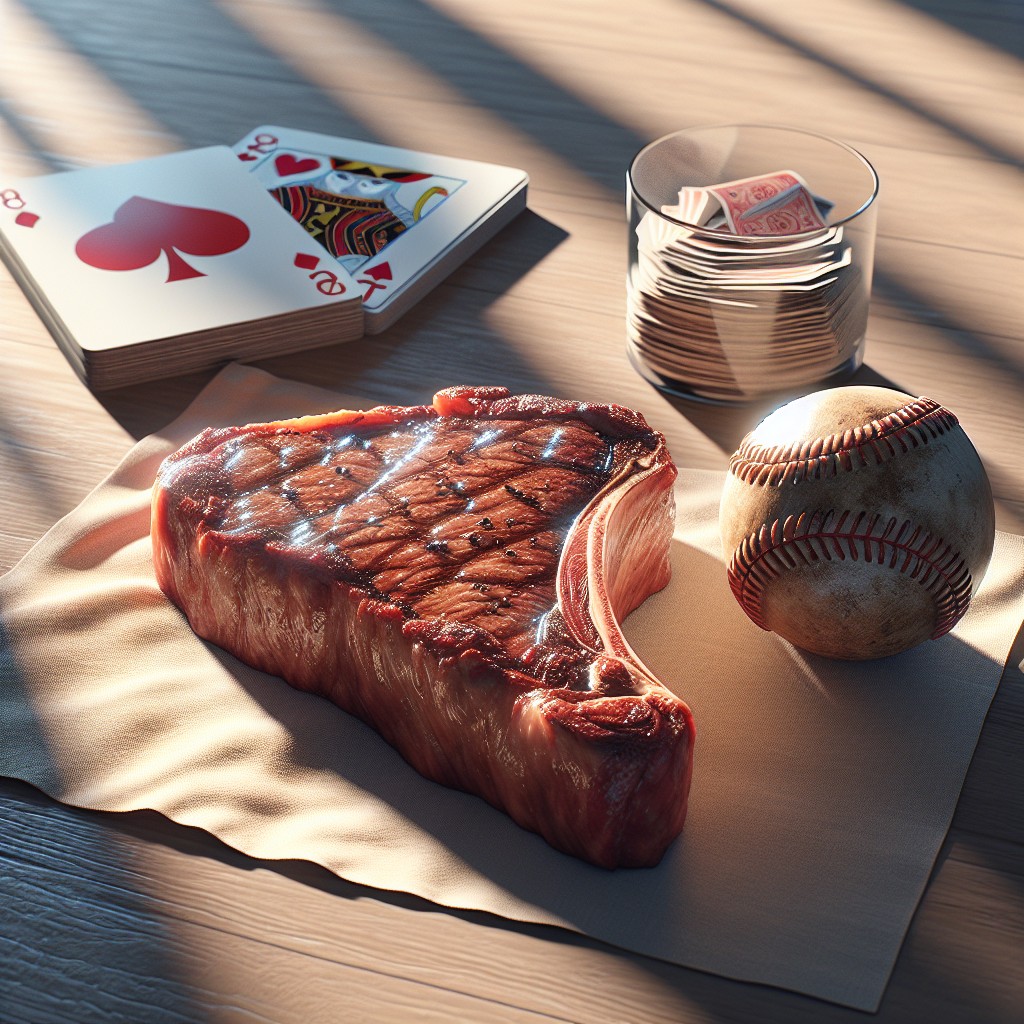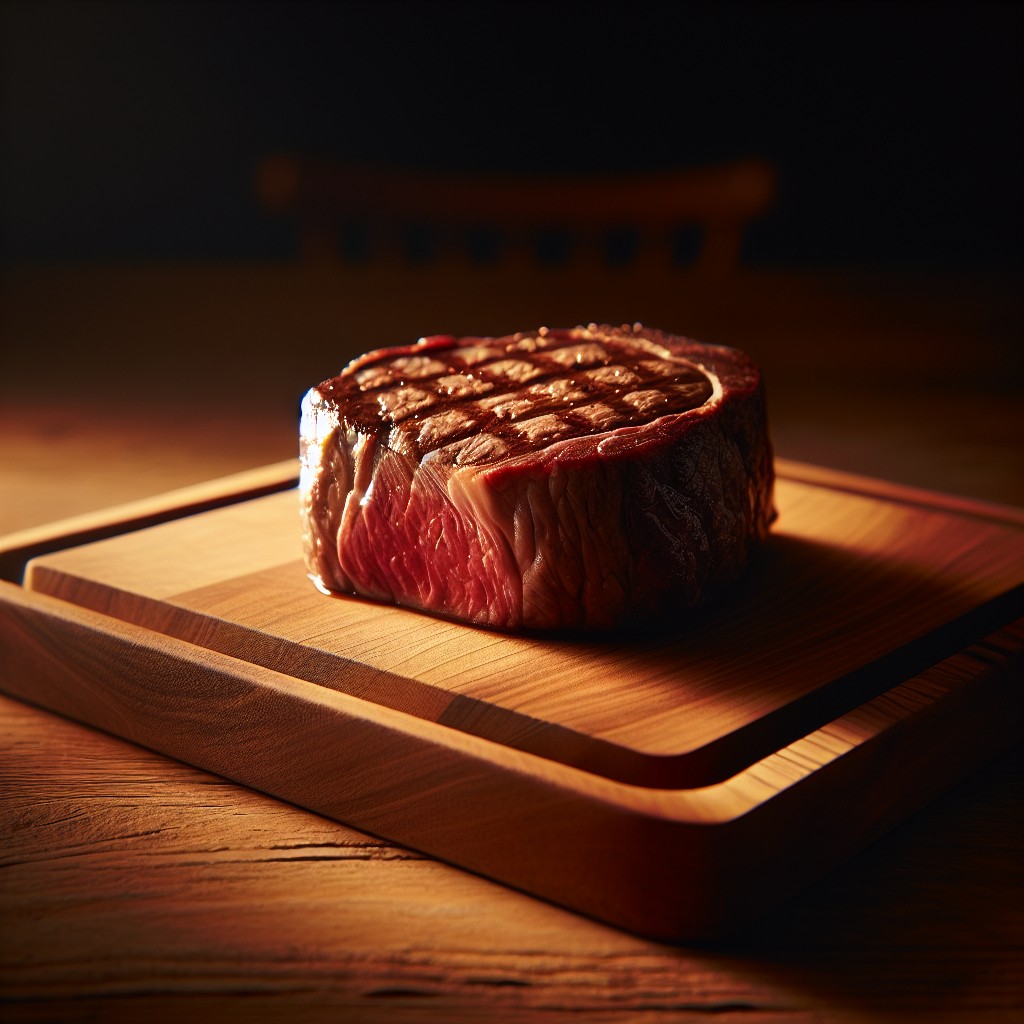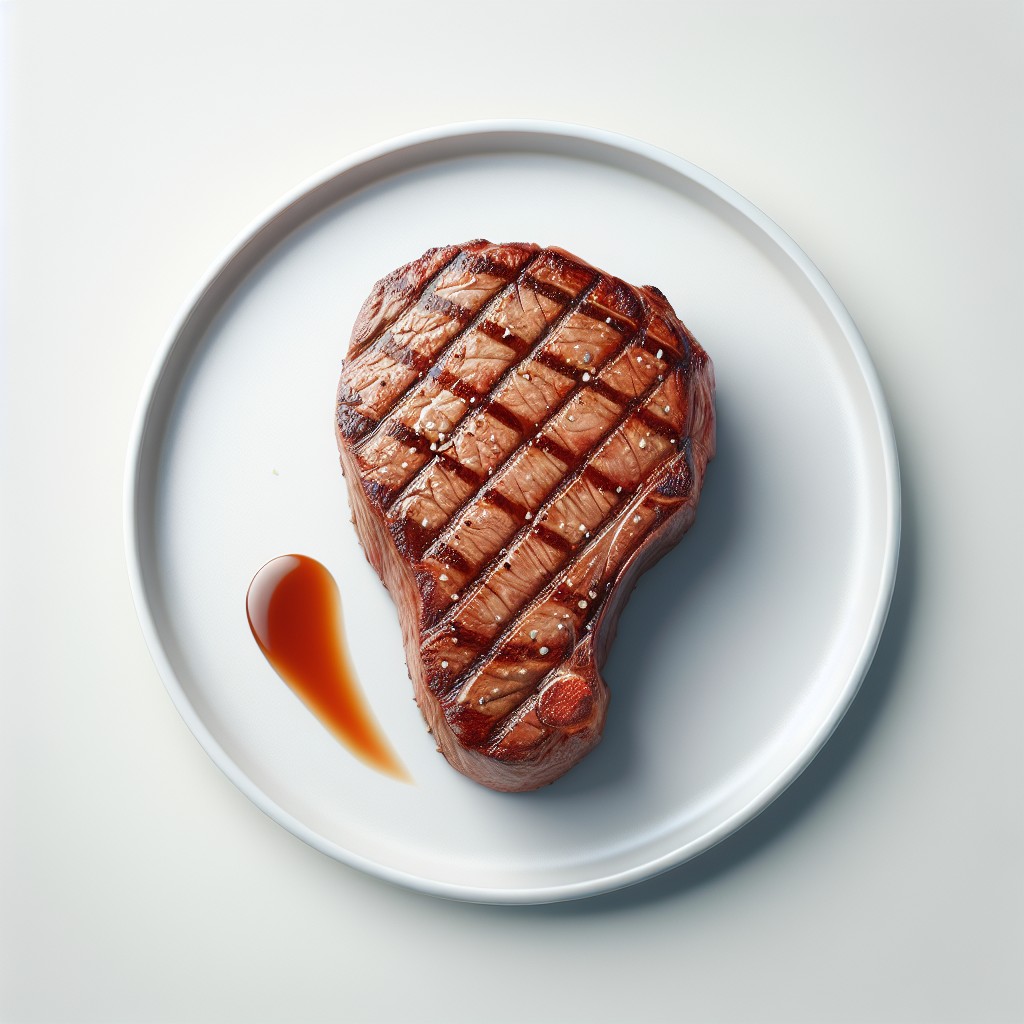Last updated on
Dive into an in-depth analysis of an 8 oz steak, exploring its size, and how it compares to common everyday objects, all while offering expert insights on its culinary significance and impact on your diet.”.
Key takeaways:
- 8 oz steak is roughly the size of a deck of playing cards.
- Filet mignon is lean and compact, ribeye is wider and thinner.
- Expect 25% shrinkage when cooking an 8 oz steak.
- 8 oz steak aligns with recommended serving size, packed with protein.
- Marbling affects size perception, prime grade steaks appear larger.
What's Inside
Visual Comparison to Everyday Objects

An 8 oz steak might be hard to picture, so let’s use common items to gauge its size. Imagine a deck of playing cards; your steak is roughly that footprint, but picture it slightly thicker, about the height of two stacked smartphones.
If you’re still scratching your head, visualize a standard sticky note – the steak would cover most of it but would have more heft due to its density.
This mental exercise helps when you’re planning portions or eyeing your plate, knowing its dimensions could be akin to these relatable objects, it adds perspective to your dining experience.
Size and Thickness of an 8 Oz Steak

A typical 8 oz steak, depending on the cut, generally measures around 4 inches wide, 3 inches long, and up to an inch thick. Imagine the size of a deck of cards or an iPhone; your steak should be roughly similar in footprint but obviously much thicker.
The thickness, however, can vary. A more lean and dense cut like a filet mignon may appear smaller, more compact, but taller, while a cut from the rib section could be broader and flatter due to the distribution of fat and muscle.
Remember, this visual guide is a rule of thumb. Given the natural variation in animal size and butchering techniques, two 8 oz steaks can look slightly different while still delivering the same weight and flavor you’re craving. When cooking, always use a food scale for accuracy if size matters in your dish.
Understanding the Cut: Filet Mignon Vs. Ribeye
Diving into the world of steak, it’s essential to recognize that an 8 oz steak will vary significantly depending on the cut. When comparing a filet mignon to a ribeye, the differences can be striking both in appearance and dining experience.
- Filet Mignon: The darling of the steakhouse, the filet mignon hails from the tenderloin, a non-weight-bearing muscle, which explains its buttery texture. An 8 oz filet mignon is typically 2 to 3 inches thick. Due to its lean nature, such a portion will appear smaller, more compact, but rich in tenderness.
- Ribeye: Known for its rich flavor, the ribeye comes from the upper ribcage area and boasts more fat and marbling. An 8 oz ribeye might be wider and thinner, about 1 to 1.5 inches, as it spreads the weight over a larger area. The generous marbling enhances the flavor, making it a favorite for those who love a juicier steak.
Understanding these distinctions helps you set the right expectations and match your personal preference for either a lean and tender experience with the filet mignon or a more flavorful and succulent meal with the ribeye.
Cooking Methods and Shrinkage
When you toss that steak on the grill or in the pan, keep in mind it’ll undergo a bit of a transformation. Here’s what happens behind the sizzle:
- Heat and Moisture Loss: As the steak cooks, heat causes its fibers to contract, squeezing out some moisture and resulting in shrinkage.
- Cooking Method Impact: Grilling often leads to slightly more shrinkage due to the higher temperatures involved compared to, say, pan-searing where the meat is in constant contact with a hot surface which can seal in juices a bit more effectively.
Expectation Management: On average, anticipate a steak to reduce in size by about 25% after cooking, so that 8 oz steak will yield roughly 6 oz of delectable meat ready to be savored.
Thickness Factor: A thicker cut might shrink less in width and length but still lose the same amount of weight as it loses moisture throughout.
Take these pointers into your prep work, and you’ll master the art of serving up a perfectly satisfying steak, with an understanding of just how sizeable it will be post-flame.
Serving Size and Nutritional Value
Understanding portion sizes is crucial for maintaining a balanced diet. An 8 oz steak aligns with the recommended serving size of protein suggested by nutritionists for a single meal. It’s important to note that such a serving provides a substantial amount of protein, essential for muscle repair and growth.
This portion typically contains about 50 grams of protein, which is a generous contribution towards the daily recommended intake, especially for physically active individuals.
Beyond protein, this steak size is also a source of various nutrients, including iron, which is vital for transporting oxygen in the blood. You’ll also receive a healthy dose of zinc, a mineral that supports immune function.
However, be mindful of fat content, especially if your selection is a more marbled cut like ribeye. This increases the calorie count, with an 8 oz steak averaging around 400 to 700 calories depending on how it’s cooked and the fat content. The exact nutritional profile varies, with leaner cuts like tenderloin (filet mignon) being on the lower end of the calorie scale.
Always remember to balance your meal with vegetables and whole grains to round out the nutritional content and achieve a satisfying, well-rounded dining experience.
Marbling and Quality Grades Affecting Size Perception
When eyeing a steak, marbling—the small streaks of fat running through the meat—plays a big role in how we perceive its size. Fattier cuts, such as a well-marbled ribeye, may appear larger than leaner ones like a filet mignon, but don’t be fooled. The actual weight remains 8 ounces despite the visual bulk.
Quality grades, designated by organizations like the USDA, also influence our perception. Prime grade steaks, known for abundant marbling, seem more substantial than their Choice or Select counterparts, which have less fat. It’s not just about looks: more marbling often equates to enhanced flavor and tenderness, making the steak not only appear better but taste better too. Keep this in mind while shopping or dining out—8 ounces of a Prime grade steak delivers both on scale and on the palate.
Product Details: What to Expect When Ordering an 8 Oz Steak
When you order an 8 oz steak, whether from a butcher or a restaurant, here are a few details you should anticipate:
- Uniformity: Steaks are typically cut to offer a consistent weight and size for uniform cooking. An 8 oz steak should look relatively similar each time you purchase it.
Thickness: Depending on the cut, the thickness may vary. An 8 oz filet is often thicker, while a sirloin or ribeye might be wider and thinner.
Packaging: Your steak should be well-packaged, either vacuum-sealed or wrapped in butcher paper, to maintain its freshness and prevent freezer burn if not used immediately.
Labeling: Expect clear labeling indicating the type of cut, weight, and possibly the grade of the beef or the farm it came from.
Price: The cost can vary widely depending on the cut, quality, and vendor. Premium cuts like filet mignon are pricier compared to more common cuts like a sirloin.
When purchasing your steak, don’t hesitate to ask the butcher for specifics about the source or best preparation methods, ensuring that you get the most out of your 8 oz steak experience.
Preparation Tips for the Perfect 8 Oz Steak Dining Experience
Achieving steakhouse-quality results for your 8 oz steak boils down to a combination of correct seasoning, temperature control, and resting time.
Season well: Generously season your steak with salt and a bit of pepper at least 40 minutes before cooking to enhance flavor and help it form a perfect crust.
Get it to room temperature: Take the steak out of the refrigerator about 30 minutes prior to cooking. This ensures an even cook throughout.
Sear for success: Use a heavy skillet or grill to sear over high heat, creating a savory crust that seals in juices.
Thermometer is key: Invest in a reliable meat thermometer. For medium-rare, aim for an internal temperature of 130-135°F (54-57°C) before resting.
Let it rest: Always let your steak rest for about half the cooking time. This allows the juices to redistribute, ensuring a moist and tender bite.
Remember, these tips are a framework for you to express your culinary creativity, adjusting where you see fit to your taste preferences.
Nutritional Information Specific to 8 Oz Portion
The average 8 oz steak packs a powerful protein punch, typically offering about 50 grams, which contributes to muscle growth and repair. Depending on the cut, fat content can vary. A leaner cut like sirloin may only have around 8 grams, whereas a more marbled ribeye could go up to 20 grams. Calorically, you’re looking at a range of 400-700 calories, but this varies widely with the steak’s fat content and specific cut.
Consider the iron content, essential for preventing anemia and boosting energy levels; an 8 oz portion can provide approximately 15% of your daily requirement. B vitamins are also plentiful in red meat, with this serving size containing a generous amount of B12, crucial for brain function and forming DNA, and B6, which supports immune health.
Don’t overlook the zinc found in steak, it supports immune function and wound healing. One 8 oz steak typically offers around 70% of the daily recommended intake for men and nearly 100% for women.
While highly nutritious, moderation is key due to the saturated fat and cholesterol present in red meat. Lean cuts or trimming visible fat can make this portion size a more heart-healthy option. Enjoy an 8 oz steak as part of a balanced diet to reap the benefits without overindulging.
Customer Reviews: Real Experiences With 8 Oz Steaks
Diving into customer reviews offers genuine insights that can’t be gleaned from raw data alone. Here’s what diners often say about the 8 oz steak experience:
- Satisfaction with Portion Size: Many express that an 8 oz steak strikes the perfect balance between leaving them sated and not overly stuffed, especially when accompanied by sides.
- Quality Over Quantity: Some note that with higher-quality cuts, such as filet mignon, the 8 oz portion is more than enough due to the richness and flavor concentration.
- Cooking Precision: Reviews frequently mention that due to the smaller size, attention to cooking temperature is critical. The difference between medium-rare and medium is often highlighted as a finer line for an 8 oz cut.
- Ideal for Certain Diets: Customers on high-protein, low-carbohydrate diets often find the 8 oz steak an ideal, controlled serving for their nutritional goals.
- Mixed Experiences with Filling Nature: While some assert that 8 oz is the perfect serving, others, particularly those with larger appetites, suggest opting for a larger size or ensuring ample sides to feel fully satisfied.
Parsing through these reviews underscores the subjective nature of dining; an 8 oz steak is sometimes “just right” or a “bit light,” depending on personal preference and appetite.
FAQ
Is 8 oz of steak a lot?
While 8 oz of steak is often suggested as a typical serving per person, individual dietary needs, appetite, and preferences may influence whether this feels like ‘a lot’ or just right.
Is 8 oz steak enough for one person?
Indeed, an 8 oz steak is typically sufficient for one person, considering it’s usually accompanied by side dishes, but for those with larger appetites or a love for leftovers, a 12 oz portion might be more appropriate.
How big is a 8oz New York steak?
An 8oz New York steak is approximately 7/8 inches thick.
How large is a 6 oz steak?
A 6 oz steak is approximately twice the size of a standard 3-ounce serving, similar to two decks of cards or two palms of your hand.
How many calories are typically found in a 8 oz steak?
An 8 oz steak typically contains around 572 calories.
What is the equivalent weight of an 8 oz steak in grams?
An 8 oz steak weighs approximately 226.796 grams.
How much protein does an 8 oz steak typically deliver?
An 8 oz steak typically delivers about 62 grams of protein.
Continue reading:



